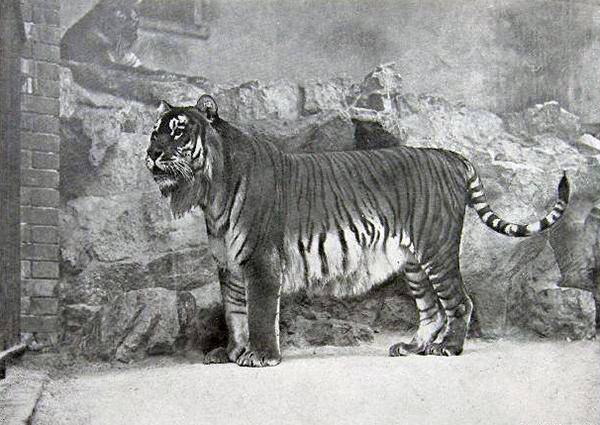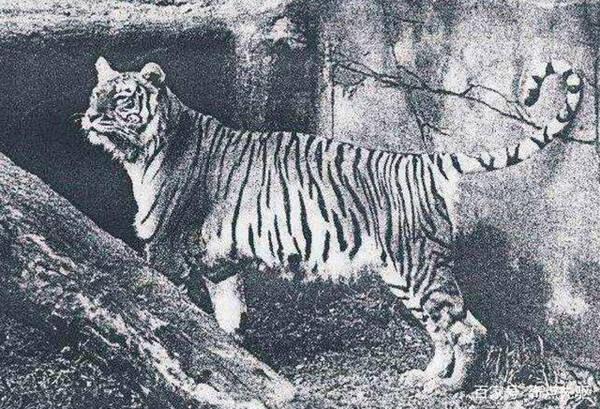Panthera tigris virgata
IUCN
LCBasic Information
Scientific classification
- name:Panthera tigris virgata
- Scientific Name:Panthera tigris virgata,Persian tiger, Xinjiang tiger, Caucasian tiger, Turan tiger, West Asian tiger, Central Asian tiger, Black Sea tiger
- Outline:Carnivora
- Family:Schizopoda Felidae Panthera
Vital signs
- length:158-201cm
- Weight:85-240kg
- lifetime:10-15 years
Feature
Second in size only to the Siberian tiger and the Bengal tiger, now extinct
Distribution and Habitat
It was once distributed in China, Iran, Iraq, Afghanistan, Turkey, Azerbaijan, Georgia, Armenia, Kazakhstan, Uzbekistan, Mongolia and Russia. It is also the only tiger species living in West Asia and Central Asia.
The Caspian tiger lives in dense poplar forests and reeds along rivers. They sometimes appear in mountainous areas, and in summer they go up to Kazakhstan and Kyrgyzstan, where there is snow all year round. Its range is mainly limited to the forested areas of the Talysh lowlands, where wild boars and other ungulates are abundant, adjacent to reed bushes along streams and marine lagoons.
Appearance
Among the known tiger subspecies, the Caspian tiger is the third largest, second only to the Siberian tiger and the Bengal tiger.
The Caspian tiger is a large carnivore, also known as the Persian tiger, with a long and strong body. The male Caspian tiger can weigh up to 169-240kg, while the female Caspian tiger is of medium size, weighing about 85-135kg. The maximum length of the male Caspian tiger's skull is 29-36cm, while the female Caspian tiger's skull is about 19-25cm long.
The Caspian tiger has yellow-brown fur all over its body, white on the abdomen and inside of its limbs, double rows of black vertical stripes on its back, many black rings on its tail, long fur, and a well-developed mane near its face.
Details
The Caspian tiger (Latin name: Panthera tigris virgata) is the third largest subspecies of tiger, second only to the Siberian tiger and the Bengal tiger. It became extinct in China in 1916, and then successively became extinct in West Asia and Central Asia, and became extinct in the 1980s.

The Caspian tiger is a solitary hunter. They like to act alone. When they find their prey, they will make a close-range raid and kill their target. After capturing the prey, they usually drag the prey to a more secluded place, and then eat leisurely alone. They can live in places with dense vegetation and water. They like to mark the boundaries by urinating everywhere, scratching tree trunks, and defecation.
Caspian tigers have no fixed nests. Both sexes have their own territories, and only come together during the estrus period, and separate after mating. Sometimes male tigers stay longer. Caspian tigers never leave the water source, and sometimes swim across streams and lakes to seek new hunting grounds. When encountering prey, they usually sneak up on the prey under the cover of grass, and then launch a surprise attack, preying on deer, antelopes and any other animals they can kill.
Tigers can also communicate with sounds such as roars, growls, grunts, and groans. Each sound has its own purpose and reflects the tiger's intentions or emotions. For example, a tiger's roar is usually a signal that tells other individuals how powerful it is and its dominance in this range. The tiger's ability to roar comes from having a flexible hyoid device - an elastic pad that allows sound to travel.
Caspian tigers generally reach sexual maturity at the age of 3 to 4 years old, and the gestation period is about 105-113 days. Female tigers will still search for prey during pregnancy. Female tigers generally give birth to 3-4 cubs at a time. Generally, no more than two survive. Dead and weak cubs will be eaten by female tigers. Newborn cubs weigh about 1,400 grams and are blind for the first two weeks. They are raised by female tigers alone and grow very quickly. 11 weeks after birth, the cubs begin to learn to hunt animals on their own. Once the cubs are sexually mature, they will be driven out by the male tigers to find their own territory. After the cubs leave, the mother tiger will start a new round of mating, giving birth, and raising cubs.

The fate of the Caspian tiger may be closely related to the "Silk Road". As the hometown of the Caspian tiger, Loulan, once became an important transportation hub in West Asia due to its superior geographical location. With the increase in population, forests were cut down in large areas, overgrazing and grasslands were cultivated, resulting in the interruption of rivers and serious desertification of land. The prosperous ancient country of Loulan also declined. Like Loulan, the Caspian tiger also encountered an unprecedented disaster. Losing the forest meant losing the food source and the beautiful home. A large number of Caspian tigers died, but a small number of them still lived tenaciously in the only oasis in the desert with their tenacious vitality. It was not until 1900 that Sven Hedin discovered the Caspian tiger. In the following decade, due to the further deterioration of the environment in this area and the hunting of Caspian tigers by some greedy people, the few remaining Caspian tigers did not escape the disaster.
In April 1980, the last Caspian tiger in the world died alone in the jungle of Gasbio. According to official investigations: except for 2 of the last 10 Caspian tigers on the earth who died of natural causes, the remaining 8 were all killed by greedy poachers. Mr. Gu Jinghe, a zoologist at the Xinjiang Institute of Ecology and Geography of the Chinese Academy of Sciences, believes that the extinction of Xinjiang tigers is related to the reduction in the number of wild boars. The main food base of Xinjiang tigers is wild boars. In the past, the wetlands in the Tarim River Basin were widely distributed. Later, due to the large amount of land reclamation, the wetlands decreased, the Lop Nur dried up, and the number of wild boars decreased sharply, and the Xinjiang tigers went extinct. Professor Yang Jian of the Chinese Academy of Social Sciences, who has visited Lop Nur several times, also believes that the destruction of natural resources has long made the Xinjiang tigers have no survival radius. The so-called survival radius is the premise that a tiger goes out to find food in the morning. There must be a place with a radius of ten kilometers that is not disturbed by people, has food to fill its stomach, and is hidden and safe. It belongs to it. If the number of tigers gradually decreases, then the possibility of extinction is greater. Because large wild animals must have more than 80 in the wild to maintain the continuation of the group. If there are less than 80, they will breed inbreeding, and the result of inbreeding will inevitably lead to extinction.
In 1981, the World Conservation Union officially announced to the world that the Caspian tiger was extinct.
Protect wild animals and stop eating game.
Maintaining ecological balance is everyone's responsibility!








